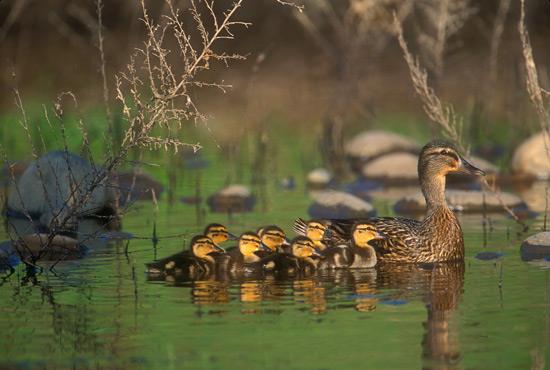Just in case you’re not sure I’m telling the truth about four kits, here’s the proof. Junior comes from the left for size comparison. One of the kits is a little meanie. I’m waiting for mom or dad to straighten him out.
We didn’t have to wait long to see all four. Hoping they agree to stay upstream through the fourth.
Now, as promised we can finally return to the fantastic Beaver article from Ducks Unlimited. It’s definitely worth our time.
 Understanding Waterfowl: Beaver Ponds and Breeding Ducks – Growing beaver populations have created an abundance of high-quality habitat for waterfowl
Understanding Waterfowl: Beaver Ponds and Breeding Ducks – Growing beaver populations have created an abundance of high-quality habitat for waterfowl

“We have mined the northland, not for wheat, not for gold—but for fur. Now the fur seed is gone.”
Those words were spoken in 1938 by Ducks Unlimited Canada’s first general manager, Tom Main. He was relating his ideas about how to resolve the challenges facing waterfowl as DU began its first year of operation. Main and many others believed that beaver ponds were an integral component of the original habitat that once produced sky-darkening flocks of waterfowl. By the time DU started its conservation work, however, nearly all the beavers and the millions of ponds they had created along the continent’s rivers and streams were gone.
Research has verified that beaver ponds provide important habitat for waterfowl. In a large study conducted by DU in the Clay Belt region of Ontario, the most abundant breeding duck in beaver pond–rich forests was the mallard. Other common breeding ducks on beaver ponds include cavity-nesting wood ducks, hooded mergansers, buffleheads, and common goldeneyes. Beaver ponds also provide breeding habitat for American black ducks, blue- and green-winged teal, American wigeon, and ring-necked ducks.
Beaver populations have now expanded across the United States. In many areas, especially in the West, beavers are increasingly viewed as key partners in the restoration of diverse plant and animal communities. Beaver ponds provide vital habitat for many species of fish, amphibians, and birds while also conserving threatened water supplies and moderating downstream flooding.
But what effect do beavers have on continental waterfowl populations? DU and others have long chronicled and fought the loss of wetlands important to waterfowl. Despite all our efforts, the net loss of wetlands has continued and even accelerated on the continent’s most important waterfowl breeding, migration, and wintering areas.
As natural wetlands have declined, man-made water bodies such as reservoirs, storm-water retention basins, borrow pits, and golf course ponds have increased on the landscape. Many man-made ponds and lakes are of limited value to waterfowl, although they do serve some wetland functions. DU and its conservation partners restore, enhance, and protect high-quality natural wetlands that provide crucial habitat for waterfowl and other wildlife. As nature’s wetland engineers, beavers are in the same business, and they do all the work themselves.
Beavers truly are a partner in wetlands restoration and maintenance, just as Tom Main had hoped they would be over 75 years ago.
High praise from a powerful lobby. I’m sure a lot of us might have mixed feelings about DU. (They want lots and lots of ducks to grow up big and strong so they can go out and shoot them.) But DU has done literally more wetlands restoration than we can imagine. They put their money where their guns are, and as a result they have saved many of the very species they are interested in hunting. They really are conservationists. Not my kind maybe, but conservationists all the same.
And they love beavers because they help them do this work. And that’s a big deal.
Not to hog all the camera time, Rusty sent a wonderful photo this week of an otter truly enjoying all that Tulocay beaver pond has to offer.

One more film from last night. This was heart-meltingly beautiful. Love mom’s foot in this video. Reminds me of a Degas painting.






 This was so long ago that I don’t even have the footage anymore, I didn’t know how to save it back them. We were just watching something wonderful in the town where we happened to live.
This was so long ago that I don’t even have the footage anymore, I didn’t know how to save it back them. We were just watching something wonderful in the town where we happened to live.






































